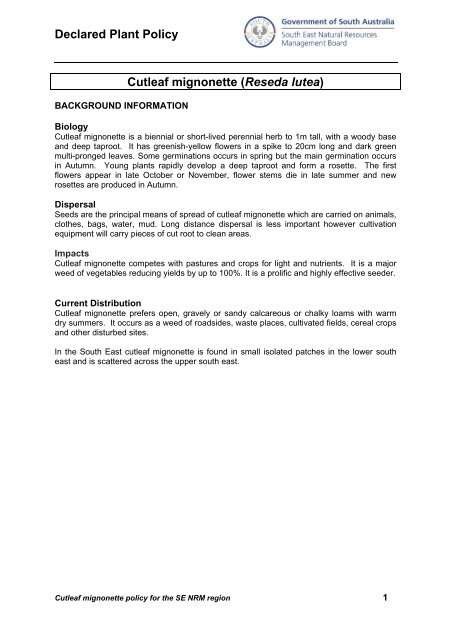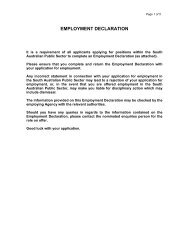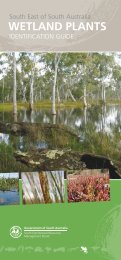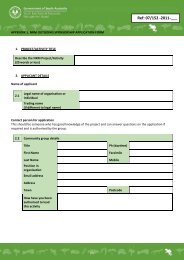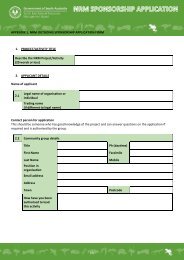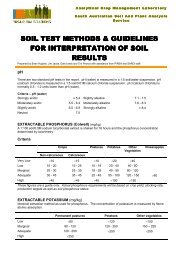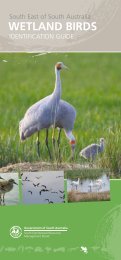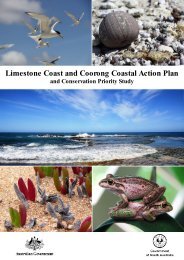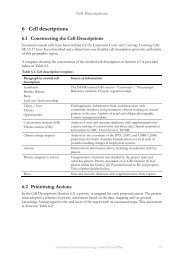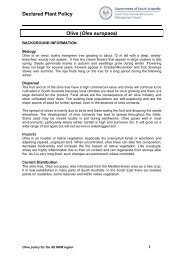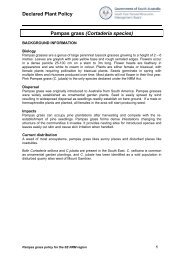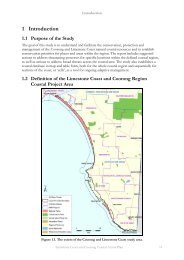Cutleaf mignonette policy - South East Natural Resources ...
Cutleaf mignonette policy - South East Natural Resources ...
Cutleaf mignonette policy - South East Natural Resources ...
Create successful ePaper yourself
Turn your PDF publications into a flip-book with our unique Google optimized e-Paper software.
Declared Plant Policy<br />
BACKGROUND INFORMATION<br />
<strong>Cutleaf</strong> <strong>mignonette</strong> (Reseda lutea)<br />
Biology<br />
<strong>Cutleaf</strong> <strong>mignonette</strong> is a biennial or short-lived perennial herb to 1m tall, with a woody base<br />
and deep taproot. It has greenish-yellow flowers in a spike to 20cm long and dark green<br />
multi-pronged leaves. Some germinations occurs in spring but the main germination occurs<br />
in Autumn. Young plants rapidly develop a deep taproot and form a rosette. The first<br />
flowers appear in late October or November, flower stems die in late summer and new<br />
rosettes are produced in Autumn.<br />
Dispersal<br />
Seeds are the principal means of spread of cutleaf <strong>mignonette</strong> which are carried on animals,<br />
clothes, bags, water, mud. Long distance dispersal is less important however cultivation<br />
equipment will carry pieces of cut root to clean areas.<br />
Impacts<br />
<strong>Cutleaf</strong> <strong>mignonette</strong> competes with pastures and crops for light and nutrients. It is a major<br />
weed of vegetables reducing yields by up to 100%. It is a prolific and highly effective seeder.<br />
Current Distribution<br />
<strong>Cutleaf</strong> <strong>mignonette</strong> prefers open, gravely or sandy calcareous or chalky loams with warm<br />
dry summers. It occurs as a weed of roadsides, waste places, cultivated fields, cereal crops<br />
and other disturbed sites.<br />
In the <strong>South</strong> <strong>East</strong> cutleaf <strong>mignonette</strong> is found in small isolated patches in the lower south<br />
east and is scattered across the upper south east.<br />
<strong>Cutleaf</strong> <strong>mignonette</strong> <strong>policy</strong> for the SE NRM region 1
Declared Plant Policy<br />
<strong>Cutleaf</strong> <strong>mignonette</strong> <strong>policy</strong> for the SE NRM region 2
Declared Plant Policy<br />
REGIONAL PRIORITY<br />
<strong>Cutleaf</strong> <strong>mignonette</strong> was assessed during the <strong>South</strong> <strong>East</strong> Weed Risk Assessment project.<br />
<strong>Cutleaf</strong> <strong>mignonette</strong> is mainly a weed of grazing areas and was considered to be a low<br />
impact for other land uses.<br />
Management<br />
Action<br />
Relative<br />
priority<br />
Aquatic Crop/pasture Forestry Grazing Irrigated Native<br />
Vegetation<br />
Perennial<br />
Horticulture<br />
Urban<br />
N/A Protect N/A Protect N/A N/A Protect N/A<br />
sites<br />
sites<br />
sites<br />
- 4 - 4 - - 4 -<br />
# Management action N/A – not assessed – low priority for this landuse<br />
LI – not assessed - low impact in this landuse<br />
* Relative priority 1 = highest priority<br />
7 = lowest priority<br />
AIMS:<br />
1. To protect grazing industries from the loss of production caused by cutleaf <strong>mignonette</strong>.<br />
2. To contain the distribution of cutleaf <strong>mignonette</strong> in the <strong>South</strong> <strong>East</strong>.<br />
OBJECTIVES:<br />
• Identification of the full extent of cutleaf <strong>mignonette</strong> infestations in the <strong>South</strong> <strong>East</strong>.<br />
• Increase awareness about the impacts of cutleaf <strong>mignonette</strong>.<br />
• Enforce control programs to prevent spread of cutleaf <strong>mignonette</strong> to un-infested<br />
areas.<br />
IMPLEMENTATION<br />
State Level<br />
• Prohibit the sale and distribution of cutleaf <strong>mignonette</strong> into and within the State.<br />
Regional Priority Actions for the SE NRM Board<br />
• Authorised Officers to map and monitor all infestations of cutleaf <strong>mignonette</strong>.<br />
• Buffer zones encouraged between severe infestations of cutleaf <strong>mignonette</strong> and<br />
‘clean’ properties.<br />
• Increase awareness about the impacts of cutleaf <strong>mignonette</strong>.<br />
• Seek external funding for projects relating to cutleaf <strong>mignonette</strong> control which will<br />
protect high value agricultural and natural environments.<br />
• Control of cutleaf <strong>mignonette</strong> enforced at priority sites (including priority roadsides)<br />
and isolated infestations.<br />
• Prevent movement of cutleaf <strong>mignonette</strong> within the region.<br />
<strong>Cutleaf</strong> <strong>mignonette</strong> <strong>policy</strong> for the SE NRM region 3
Declared Plant Policy<br />
Local action<br />
• All landholders to implement active control programs according to seasonal<br />
conditions and the instructions of the Authorised Officer.<br />
• Landholders to follow farm hygiene practises to prevent spread of plant.<br />
• Implement buffer zones annually according to authorised officer instructions.<br />
• Ensure stock in infested paddocks are cleaned out or shorn prior to transport/sale.<br />
DECLARATIONS<br />
The following sections of the NRM Act apply to <strong>Cutleaf</strong> <strong>mignonette</strong> in all Local Government<br />
areas in the <strong>South</strong> <strong>East</strong> NRM region:<br />
175 (2) Cannot transport the plant or anything with the plant in it<br />
177 (1)<br />
(2)<br />
182 (2)<br />
(3)<br />
Cannot sell the plant<br />
Cannot sell any produce / goods carrying the plant<br />
Land owner must control the plant on their land<br />
Land owner must take prescribed measures for the control of<br />
the plant on their land<br />
185 (1) NRM authority may recover costs for control of weeds on<br />
roadsides from adjoining land owners<br />
Implementation<br />
Responsibility of Operations Manager<br />
Periodic Review<br />
Responsibility of Operations Manager<br />
Date endorsed by the SENRMB 25 February 2010<br />
Date scheduled for review 2015<br />
Version Date Version Reference Sections Description of Changes<br />
Feb 2010 1 Whole Document Endorsed By SENRM Board<br />
Released to public<br />
March 2011 2 Whole document Review and update of distribution maps<br />
<strong>Cutleaf</strong> <strong>mignonette</strong> <strong>policy</strong> for the SE NRM region 4


